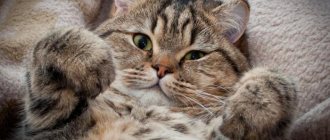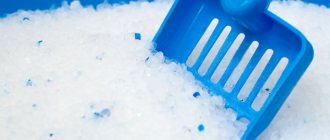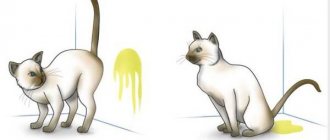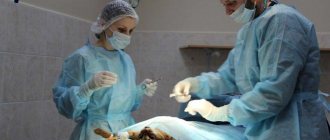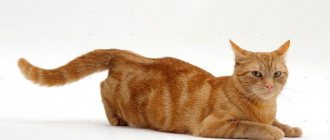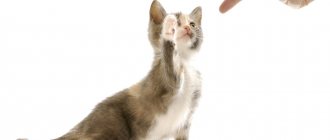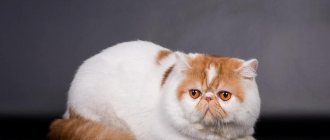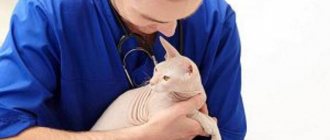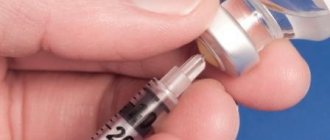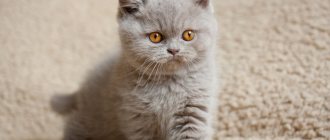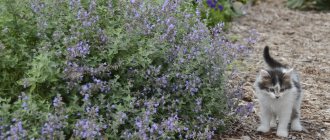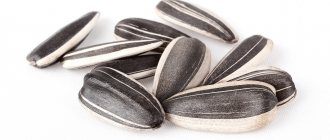Noticeable signs of aging in cats are manifested in changes in behavior, decreased performance and sensitivity of the organs of smell and hearing. A decrease in motor activity manifests itself through impaired functioning of the vestibular apparatus and refusal to hunt. The animal's chronic diseases worsen and new age-related ones appear. To prevent and treat them, regular visits to the veterinarian are necessary.
Age at which cats become old
On average, an animal lives from 12 to 15 years. Previously, to determine age, 1 year was considered 7. Later, this algorithm was adjusted. Veterinarians have noticed that there is no linear correspondence. Now the year of a pet’s life, by analogy with a human life, is calculated differently, as the table shows:
| Years of a cat's life | Appropriate for a person's age |
| 1 | 18 |
| 2 | 25 |
| 3 | 30 |
| 4 | 34 |
| 5 | 37 |
| 6 | 40 |
| 7 | 45 |
| 8 | 50 |
| 9 | 54 |
| 10 | 58 |
| 11 | 60 |
| 12 | 62 |
| 13 | 66 |
| 14 | 70 |
| 15 | 75 |
Timely treatment of an animal's ailments will prolong its life.
The bifurcation point is considered to be the age of 7 years, when a still mature cat becomes infertile, provided that it is not sterilized. If you provide adequate care for an old cat, treat illnesses promptly and correctly, then your pet will live to a ripe old age, which by human standards corresponds to 105 years. It is important to notice age-related changes in time, which are characterized by specific symptoms.
Nutritional Features
Just like humans, cats experience some digestive problems as they age. Changing a cat's diet is always a big stress.
In order not to subject the animal to such a test as a sudden change in the daily menu, veterinarians advise changing the diet starting from the age of 7.
And this needs to be done gradually.
Owners of older cats will have to deal with various features of their digestion:
- Slow digestion of food, intolerance to heavy meals and poor absorption of nutrients.
- Inability to eat food that is served in large pieces.
- Non-acceptance of many previously familiar foods by the digestive system.
- Stool disorders, manifested in the form of frequent constipation or diarrhea.
- Nausea and vomiting.
- Dysbacteriosis.
- Bloating.
- Weight loss or, on the contrary, rapid weight gain.
All of these symptoms cause a lot of inconvenience and anxiety not only for the cat, but also for the owner.
Solving problems with the gastrointestinal tract. To protect your cat from problems with the digestive system, you must follow the appropriate recommendations and rules:
- Consultation . The most correct way to organize nutrition for an elderly pet is to consult a veterinarian. The specialist will diagnose the state of the digestive system and select nutrition in such a way as to prevent the development of diseases if there is a risk of their occurrence.
- Fractional meals . Older cats prefer to eat little but often. The recommended frequency of serving food is 3 to 4 times a day.
- Serving food . The food is crushed because cats will not be able to chew large pieces. For better digestibility, it is recommended to warm the food a little.
- Vitamin supplements . Cats that are accustomed to eating only natural products should, in addition to them, receive special vitamins intended for older individuals.
- Serving meat dishes . They should always be supplemented with mineral complexes.
- Supplements . A small amount of vegetable oil should be added to vegetable and fermented milk dishes. Just 1 drop is enough. Recommended oils are olive, flaxseed or corn.
- Replacement of feed . The industrial food familiar to the animal must be replaced with specialized dry food appropriate for old age.
- Prohibited Products: fatty and heavy foods, sweets and confectionery, baked goods and baked goods, fried and salty foods, marinades.
In addition, owners should ensure that the pet regularly drinks enough water.
Obesity
A sedentary lifestyle, a slower metabolism and a number of age-related changes in the functioning of the digestive system are factors that provoke the development of obesity in an elderly cat. Neutered pets are especially susceptible to this. Obesity causes many serious diseases in cats: diabetes, kidney and liver problems.
To avoid rapid weight gain, it is necessary to feed your pet the right, healthy and low-calorie foods, and provide specialized food for older cats. Don’t forget about regular but moderate physical activity and outdoor games.
Signs of aging
Behavior change
If at a young and mature age the animal was playful and affectionate, but in old age the character became more irritable, then the cat is aging. Older cats receive less pleasure from their owner's affection and stop accepting them. It happens the other way around: old age makes a pet annoying, he constantly pets. The cat’s character traits change; the previously fearless animal becomes frightened by the usual sounds and movements of the owner, becomes nervous, and is cautious.
Decreased activity
As pets age, they prefer to bask in the sun rather than run.
Decreased mobility also indicates age-related changes. Previously, the cat could run around the house all day, play with various objects, and jump on cabinets. Now she moves and meows less, lies more in the sun, sleeps a lot, and does not lead the usual “hunting” lifestyle at night. She has become indifferent to outdoor games and communication, and it is difficult to cheer her up.
Reduced sensitivity
The sensory organs of animals that age react less strongly to external stimuli. Problems arise with hearing, smell, and functioning of the vestibular apparatus. The owners notice changes that manifest themselves as follows:
- The cat does not respond to its name, does not respond.
- Orients himself in space worse.
- Can’t smell food, the cat needs to poke his nose into the bowl for the pet to start eating.
- The hunting instinct disappears.
Deterioration of coat condition
The older an animal gets, the worse its coat begins to look.
It is believed that diseases of old cats are reflected externally.
Problems first affect the coat. It fades, hairs fall out, and new ones hardly grow, the animal does not lick itself well, which is why tangles form. The procedures necessary in such cases help little, the cats look bad. Often a pet loses weight - this worsens its appearance, and little can be done in this situation.
Mobility and games
An aging cat prefers to spend most of its time lying down. But activity and mobility are the key to ensuring that your pet will not have problems with the musculoskeletal system.
The most common disease in older cats is arthritis.
It and a number of other pathologies can be prevented by following medical recommendations:
- Regular games with your pet are required . Even an elderly cat will not refuse to spend time with its owner playing actively with its favorite toy. But you can't overdo it with activity. It should be remembered that the animal gets tired quite quickly.
- Limiting contact with children . If there are small children in the house, it is recommended to protect the cat from frequent contact with them. Elderly pets need peace and quiet. If children frequently tug on your pet, this can cause severe stress, which will further worsen the health condition.
- Arranging a home to suit the needs of an aging pet . Trays, bowls, and the cat's sleeping place should be within easy reach.
- Preventing cats from walking up stairs . It will be difficult for the animal to do this.
- It is important to pay special attention to the litter tray. Many cats find it very difficult to get into a tray with high sides as they age. In such cases, the pet has no choice but to relieve itself near him. You should not scold the animal. It is necessary to purchase a tray with the lowest possible sides.
Problems of an aging animal
Caring for an old cat involves, first of all, paying attention to its health. His chronic diseases worsen and new age-related symptoms appear. You need to visit the veterinary clinic more often and have your blood tested for preventive purposes. Sick pets should receive the necessary and timely treatment. This will reduce the problems associated with old age.
It is believed that if an old cat eats a lot, this indicates a lack of attention.
Helping an aging cat
Grooming
It becomes difficult for an older cat to care for its fur. A healthy animal thoroughly washes and combs its fur with its tongue, but with pain in the spine and joints, or weak muscles, it becomes impossible to reach some areas.
The owner should comb the cat every day with a slicker brush, and also run a slightly damp grooming mitt over the fur. This will avoid the formation of tangles or at least detect them in time. If the wool has already felted, a hygienic haircut is necessary.
Inspection and nail trimming
In older animals, the change of the horny cover of the claws may be impaired, especially if the cat does not use the scratching post as actively as before. An overgrown claw bends and digs into the pad, causing severe pain and suppuration. Particularly susceptible to this problem:
- Persians;
- exotics;
- Scottish and British cats.
If the claw once digs into the pad, it will need to be trimmed regularly with a nail clipper (once every 2 weeks).
Stimulating activity
As cats age, they become increasingly less interested in their environment, preferring to lie in a warm place and doze. But to slow down muscle atrophy, aging of joints and to help the intestines work better, furry couch potatoes need to move.
Many cats that do not play on their own are willing to run if their owner teases them. For this there is:
- laser pointers;
- fishing rods with feathers;
- or a regular bow on a string.
Appetite stimulation
As cats age, their sense of smell and taste becomes dull, which can lead to a loss of interest in their usual food. Food with increased attractiveness and aroma, food additives (anchovy juice, tuna, sardines) can solve the problem. The food is heated (possibly in the microwave), then the smell is stronger.
You can mix your favorite treat and recommended food, or use supplements such as VIYO Reinforces prebiotic drink for older cats.
Visit to the tray
In older animals, intestinal motility slows down and constipation may occur. Feces become dry and hard, making going to the toilet painful and stressful. The owner needs to monitor the regularity of bowel movements, stimulating timely bowel movements if necessary. To do this, use internally:
- malt paste (for hair removal);
- Vaseline oil;
- Duphalac.
There are special diets high in fiber.
Regular urination is equally important. The tray should be easily accessible for an elderly kitty. If the house is large enough, it makes sense to place several cat litter boxes in different rooms. When there are several floors, this is a prerequisite.
Asylum
Every cat needs a secluded place where no one will disturb it. But for an old animal that has difficulty jumping, it becomes more difficult to find such a place: the cat stops climbing onto the closet and jumping on the furniture.
The pet is given a house on the lower tier - it can be an ordinary cardboard box. Children should be told that their furry friend needs some rest and can't play with them like he used to. Sometimes it is necessary to isolate a cat from dogs, because in old age it is more difficult for her to defend herself and protect her “place in the sun.”
Stability
Cats don't like change and can even get sick due to stressful situations in their lives. The older the animal becomes, the more sensitive it perceives any innovations. Although we cannot protect our pet from global changes (the birth of children, moving to a new home), we should maintain the usual routine as much as possible. Do not rearrange furniture, feed at the same time.
Often owners, noticing signs of old age in a cat, bring a new, young pet into the house. Some even believe that this will benefit the old lady - the kitten will play with her and stir her up a little. But it’s better to wait to purchase a kitten, since its appearance will significantly spoil your pet’s peaceful old age. It is difficult for older animals to compete with their young relatives, and they experience severe stress.
Love
Even if at a young age the pet had an independent character, in old age the attitude towards signs of attention changes. The owner should show his cat affection every day. Stroking and scratching can be very pleasant, and they also have medical benefits. A light massage stimulates blood circulation, improves the condition of the skin and muscles.
